A GOOD REGENERATIVE RECEIVER
WITH SIMPLE FINE TUNING
(2008)
KLIK HIER VOOR DE NEDERLANDSE VERSIE
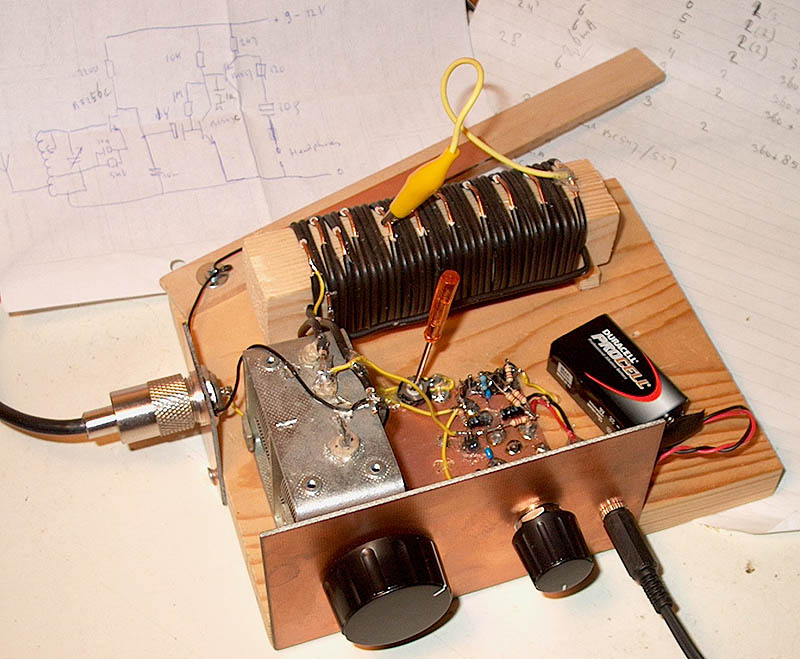
A good SSB-CW-AM regenerative receiver with a fine tuning by moving
the wooden stick with a grounded piece of PCB towards the coil.
A good regenerative receiver
When you add an LF stage and a fine tuning to the simple receiver with only one fet, you will have a much better regenerative receiver. No audio transformer is required anymore, the audio signal is much stronger and you do not need to use special, sensitive headphones anymore. By adding a simple fine tuning, tuning to SSB stations is not a problem at all, not even on the high 18MHz band, reception of that band is very good with this receiver!
Of course you cannot compare this receiver with a real good commercial receiver. But you can experiencef how it is to work with such a historical regenerative receiver. Controlling the receiver is very special. To adjust the feedback, continuously retune a little to correct the frequency drift, to adjust the RF attenuator. That was exactly how they did it in the past! And you will be astonisced about how much you can receive with it! On all bands from 1.8 MHz to 18 MHz, many amateurs can be heard with a wire antenna of 5 meter! It is nice to play with it. To rotate the tuning knob slowly or very fast, and to be surpised about the strange signals that you will hear. Listening to remote broadcast stations and to be astonished about how strong these broadcast stations are compared with the signals of amateurs. With this receiver, you can receive the whole shortwave band upto 30 MHz, and even a part of the medium wave. But above 21 MHz, it does not work very good anymore, depending on the construction and the used fet, it might be that the receiver does not generate anymore at these high frequencies.
A simple and cheap construction
We want to make this receiver to experience how it was in the past, when radio operators had to work with such simple regenerative receivers. But we want to use easily obtainable parts and of course it should be cheap. Therefore, only one variable capacitor is used, it is also the only RF component that has to be bought. For the antenna coupling and the regeneration, potentiometers are used. And the fine tuning is also made without a variable capacitor.
This receiver is a nice home brew project. It is so simple, that the construction of it cannot go wrong.
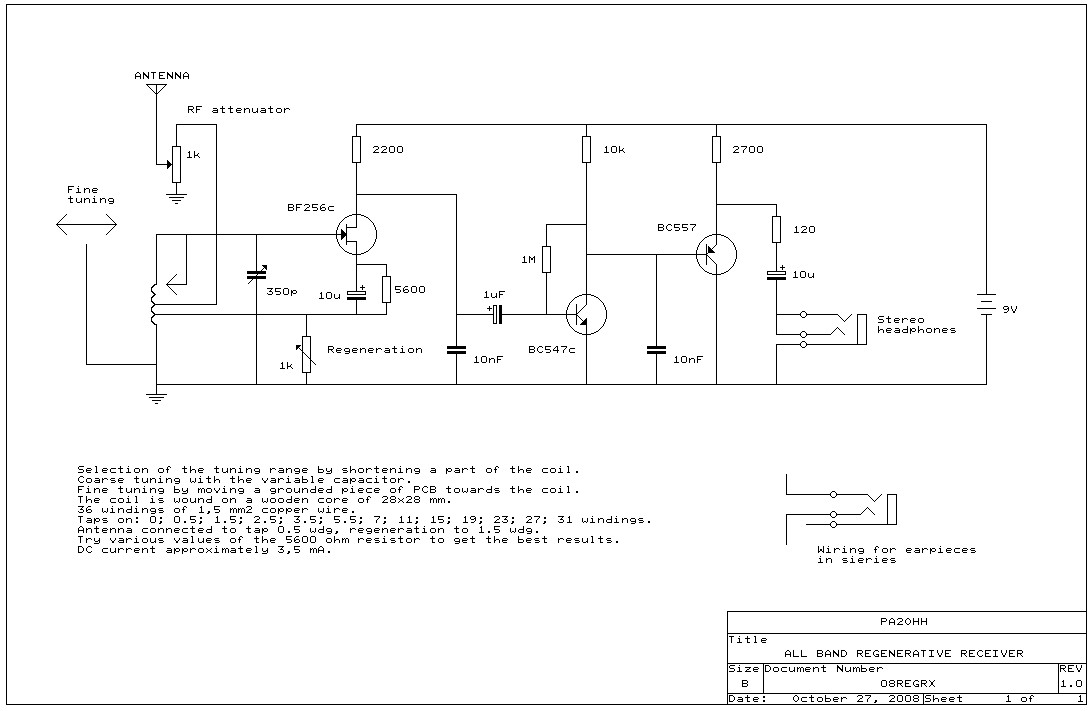
Diagram of the regenerative receiver.
Description
The heart of the circuit is the fet BF256c (c type has the highest gain). By means of the 5600 ohm resistor, it works in the non- linear part of the Id/Vgs characteristic. Experiment with that value in your receiver for the best performance. The 10uF capacitor is for decoupling of the resistor, also for high frequencies. Perhaps that you need to add an extra 0.1uF capacitor in parallel for decoupling of the RF frequencies but I did not hear any difference. The regeneration is controlled by means of the 1k potentiometer. Adjust it for maximum sensitivity. In the original simple receiver, 10k was used, but 1k is a much better value.
A transistor BC547c amplifies the LF signal and the BC557 is the replacement of the audio transformer. It has a high impedance input and a low impedance output. Sensitivity and sound level are good. If you want more audio signal, then you can connect both pieces of the headphones in series! Quite often, the signals are too strong and then some RF attenuation is necessary. We can do that with the 1k adjustable potentiometer with a small screwdriver. Of course it is better to use a normal potentiometer with a knob at the frontpanel. This potentiometer is also the only volume control in the receiver.
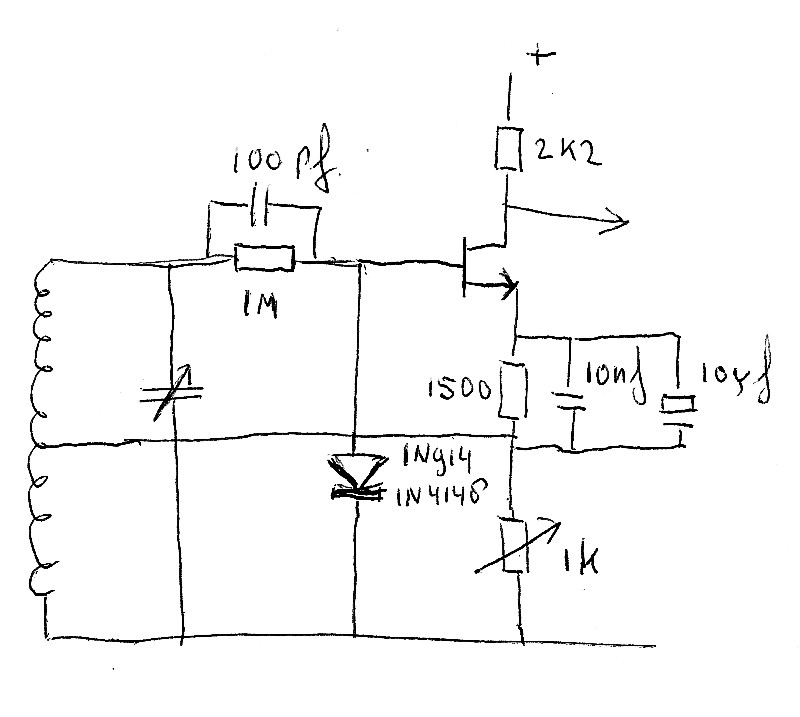
Modifications: a diode, 1M ohm resistor and 100pF capacitance have been added to the circuit.
And the value of the 5600 ohm resistor has been reduced to 1500 ohm.
Modifications
The receiver worked fine. But with a few extra parts it is possible to improve the regenerative detector. The diode, 1M ohm resistor and 100pF capacitor are the new, better detector. Detection is therefore no longer done by the non-linear characteristic of the FET, but by the diode. And the 5600 ohm resistor has been reduced to 1500 ohm. The FET has a lower bias voltage and the gain is therefore higher. The regeneration is also smoother. As soon as the oscillation starts, the diode detects it and gives the gate an extra negative bias, which lowers the gain. The oscillation is thus counteracted. There is no more quenching. A 10nF capacitance is connected in parallel to the electrolytic capacitor, because an electrolytic capacitor does not always have a low impedance for high frequencies.
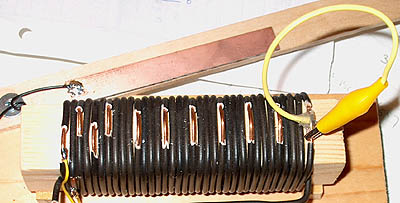
The coil in use for 80 meter. for the other
bands, a part of the coil is shortened.
The coil
The coil is wound with 1,5mm solid copper wire (black) on a square strip of wood of 28x28 mm. The windings with a tap are pulled upwards a little and the isolation is removed. The short from the top are connected to these taps with a wire with a crocodile clip. I used a standard cord for that, but the wires are not soldered to the clip. SOLDER THIS WIRE AT THE BACK SIDE TO THE CLIP!! Otherwise you will have some contact resistance between the clip and the wire after a few years. The correct tap is determined experimentally. The receiver is very sensitive and it is not necessary to look for the best tap for the antenna and source. They are permanently connected to 0.5 windings and 1.5 windings. But for 10 meter, the antenna has to be connected to a lower tap. So it is better to have a switch for the selection of 2 taps for the antenna.
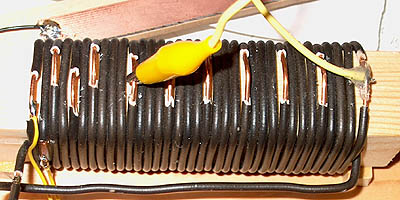
The coil in use for 20 and 30 meter.
Coarse tuning with the variable capacitor
Coarse tuning can be done with the variable capacitor. The various shortwave bands are selected by shortening a part of the coil. And 160 meter is selected by adding a capacitor in parallel to the coil. I use the second part for the variable capacitor for that purpose.

The coil in use for 160 meter. An extra capacitor is added,
I use the second part of the variable capacitor.
Fine tuning
The fine tuning by moving your hand towards the coil is quite tiring. But we have a simple solution for that. A wooden stick with grounded piece of PCB that rotates around a screw. Drill a hole with the size of the screw in the stick and fix the screw with nut so that it moves smoothly. With this fine tuning, you can tune alsmost the whole CW or SSB part of the 40 meter band! You can change this frequency range by changing the size of the PCB.

Fine tuning with the stick with grounded piece of PCB.
It rotates around the screw with nut on the leftside.
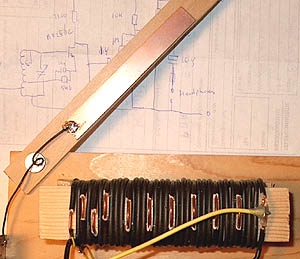
Close to the coil, the fine tuning works more coarse then when
it is far from the coil. This position is good for the higher bands.
Supply
The receiver works excellent with a supply voltage of 9 to 12 volts, supply current is approximately 3.5 mA. Reversing the battery did not damage the receiver. Perhaps that you need to connect an elco of 100uF across the plus and minus for certain batteries or power supplies. If you want, you can reduce the supply current with 1 mA to 2.5 mA by increasing the emittor resistor of the BC557 to 5600 ohm. Then the maximum audio power in the headpones is somewhat less, but in most cases still more than enough.
Results
The sensitivity is approximately 0.5 to 2 microvolts on all bands. S9 is 50 uV, S8 is 25 uV and so on.
In practice, that means that you can receive CW signals of S5 to S6, for SSB signals S6 tot S7. On all bands from 1.8 MHz to 18 MHz, many amateurs were received with SSB with a wire antenna of 5 meters length. The sound level is excellent. Often, the RF attenuator has to be used (the 1k trimmer potentiometer with screwdriver). For the reception of broadcast stations, it is not necessary to connect an antenna, the coil and wiring do receive already enough signal.
Reception of AM broadcast stations is excellent when the receiver is oscillating very weak.When tuning to the AM station, the oscillating receiver synchronises to the carrier.
Of course you can change the receiver in accordance with you own ideas and wishes. It is for example possible to replace the variable tuning capacitor by a few switches with fixed capacitors of for example 200pF, 100pF, 50pF, 25pF that can be switched in parallel to a small (homebrew?) variable capacitor of 30 pF.
The fine tuning is excellent, it is a nice regenerative receiver, with which you can receive a major part of the shortwave and even a part of the medium wave band.
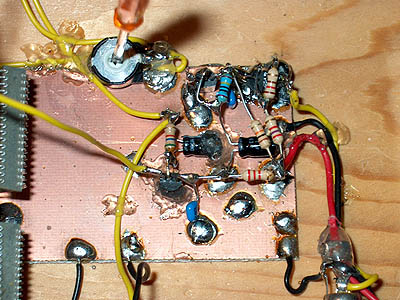
The simple small electronic circuit. Unbelievable,
but you can receive the whole world with it!
My frequency scale
The next table is used as a scale to tune to the various bands.
The 5.3 MHz band is an amateurband that is used in the UK.
The bands can be recognized by the many CW signals that you can hear at the lower ends of the amateur bands. Just above the 40 meter band and just below the 30 meter band, there is a broadcast band with many broadcast stations. Also nice useable signals to find the amateur bands.
Band
MHz | Antenna
tap | Source
tap | Top
tap | Tuning
(degrees) | Sensitivity |
| 1.8 | 1 (0.5wdg) | 2 (1.5wdg) | 12 (35wdg) + extra Cap. | 160 | 4 uV |
| 3.6 | 1 (0.5wdg) | 2 (1.5wdg) | 12 (35wdg) | 260 | 2 uV |
| 5.3 | 1 (0.5wdg) | 2 (1.5wdg) | 12 (35wdg) | 360+10 | 2 uV |
| 7 | 1 (0.5wdg) | 2 (1.5wdg) | 8 (19wdg) | 350 | 1 uV |
| 10.1 | 1 (0.5wdg) | 2 (1.5wdg) | 6 (11wdg) | 360 | 0.5 uV |
| 14 | 1 (0.5wdg) | 2 (1.5wdg) | 6 (11wdg) | 360+95 | 0.5 uV |
| 18 | 1 (0.5wdg) | 2 (1.5wdg) | 5 (7wdg) | 360+90 | 0.5 uV |
| 21 | 1 (0.5wdg) | 2 (1.5wdg) | 5 (7wdg) | 360+150 | 0.5 uV |
| 24.9 | 1 (0.5wdg) | 2 (1.5wdg) | 4 (4.5wdg) | 360+135 | 1 uV |
| 28 | 0 (0.1wdg) | 2 (1.5wdg) | 3 (2.5wdg) | 360+85 | 2 uV |
Is this regenerative receiver a radio interference source?
When a regenerative receiver is oscillating, it can cause radio interference in the reception of other receivers. A part of the oscillator signal is transmitted via the antenna that is coupled to the regenerative detector. You can avoid this by adding a RF amplifier stage between the antenna and the regenerative detector. However, adding a broadband RF amplifier was not a succes, it was often overloaded by all kinds of strong signals. And a tuned RF amplifier was too complex for this simple receiver. Furthermore, we will not have the experiences as they had in the past, influences that antennas moving in the wind have on the reception frequency and regeneration.
But is this receiver really a terrible radio interference source? I do not think so, the oscillator power is at least already 100x lower than that of a tube receiver... I had the possibility to do some measurements. Between 1.8 MHz and 7 MHz, the emission was approximately -30 dBm (1 microwatt). Between 10 MHz and 24 MHz the emission was -25 tot -20 dBm (3 to 10 microwatt) and on 28 MHz again approximately -30 dBm (1 microwatt). That is not much, and it is only 1 signal on 1 frequency. And that frequency is your own reception frequency. So you can hear what you will disturb. When listening to SSB stations, your oscillator signal is exactly on the frequency of the suppressed carrier and will not cause any inconvenience.
The possibility that someone in your neighbourhood listens to the shortwave band is very small. And endless smaller is the chance that he is listening on the frequency of your regenerative receiver. So the chance that you will cause radio interference is almost zero!
Index PA2OHH









